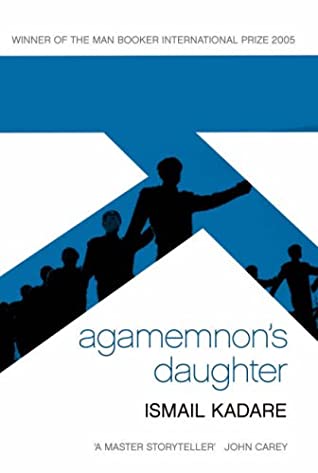When it comes to reputations, Ismail Kadare’s is one that certainly precedes him. Having come from nowhere (well, I hadn’t heard of him, at least) to scoop the inaugural MAN Booker International Prize in 2005, his works have steadily appeared in larger scales on book shop shelves. A couple of years back I sampled one of his books at random – Spring Flowers, Spring Frost, if you must know – and didn’t feel I got much out of it, which I put down to my own cultural ignorance.
That same ignorance showed up again when I read his novella, Agamemnon’s Daughter (1985), and I found myself plodding through page after page unengaged. And then the ending came along, with its explosive epiphany, and, tying everything together, hit the mark. It was just a pity I didn’t really see how it had come to this. So, after a bit of research on the subject matter I decided to read the story again and this time round everything fell into place. Or fell into step, as the cover nicely implies.
Beginning with an unnamed narrator patiently awaiting his lover we enter into 1980s Albania, a country so staunchly sticking to Marxist-Leninist ideals that even the Soviet world around it has left it behind and China is its only ally. Such are the sacrifices for sticking to one’s guns. And sacrifice is precisely what Agamemnon’s Daughter is all about, the narrator analogising his current situatution with that of Iphigenia, sacrificed by her father in order to bring the wind so that the Aechaean fleet could sail.
The sacrifice of the story’s events concerns the narrator’s lover, Suzana, giving him up for her father’s career:
It was getting harder and harder for her to see me, she said. Papa’s career was on the rise…Their family was more than ever in the limelight…Two weeks before, at the last plenum of the Central Committee, Papa had gone up another rung…So it was obvious she would have to make changes to her way of life, to her wardrobe, to the people she saw. Otherwise she might hurt his career.
To soften the blow, the narrator has been invited to the grandstand for the May Day celebrations. It’s a privilege that others wish upon themselves, so to receive such a calling evokes jealousy and disbelief:
It was the first time I had been entitled to sit in the grandstand at the May Day parade, and I still could not quite believe that it was my own name written on the card. When I first received it, the Party secretary seemed as stunned as I was. It wouldn’t be fair to say that the only emotion in his eyes was that of envy: there was also stupefaction.
It’s the journey to the grandstand and the ultimate understanding of the Agamemnon analogy that move the book along. While not much action can be said to happen in the present, Kadare uses the man’s journey to criticise Albania and its policies. To do so he uses layers of myth that strengthen the narrative, recounting incidents about the absurdity of the Socialist agenda as characters are spotted amongst the May Day crowds.
It’s the loss of Suzanna, though, that continues to bring the narrator back to the idea of Iphigenia and of sacrifice. He resigns the idea that maybe he is stretching it, pushing the notion too far:
I’d got hold of the word sacrifice and then used it to contrive an analogy I’d taken further than was warranted. I was no better than a novice poet who manages after much effort to spawn a metaphor, then falls for it entirely and constructs an entire poetic work on a foundation no more solid than sand.
But, come the end, the sacrifice is certainly there but the offering is not what he thought.
Bundled with Agamemnon’s Daughter are a further two stories that also take sacrifice as their theme. While neither of these are as interesting as the title story, or carry the same level of depth. Of the two, The Blinding Order, set during the Ottoman Empire’s reorganisation, is the stronger piece, delivering a story that is, on the surface, absurd but equally frightening. Closing off the collection, The Great Wall tells the story of China from both sides, and while the analogies are interesting, the story is the weakest aspect.
While it’s good piece of literature I daresay it would be hard to enjoy the story of Agamemnon’s Daughter, for its tone never truly excites. What it does do, though, is provide an interesting insight into the world of Albania, the people stifled and oppressed by its politics. A suitable example of such would be the book itself which, due to its criticism of Albania, had to be smuggled out of the country a few pages at a time. Unfortunately, the translation is from French rather than Albanian and so there’s a sense that, with the story having been through the wringer twice, some of the translation has echoes of the French.
But the language is still engaging and once in line with Kadare’s writing, curiousity drives the reader on. It’s an absorbing read – and there’s plenty to absorb – as we follow one man’s journey in an oppressed nation where the will to survive, no matter how hard it becomes, wins through. So four Marx out of five and, in the spirit of socialism, everyone should read it.

Hi! I was surfing and found your blog post… nice! I love your blog. 🙂 Cheers! Sandra. R.
Spring flowers, Spring Frost and Agamemnon’s Daughter are not really considered as Kadare best books. I would say Broken April,Chronicle in Stone and The Palace of Dreams is a very good start with Kadare’s writings.